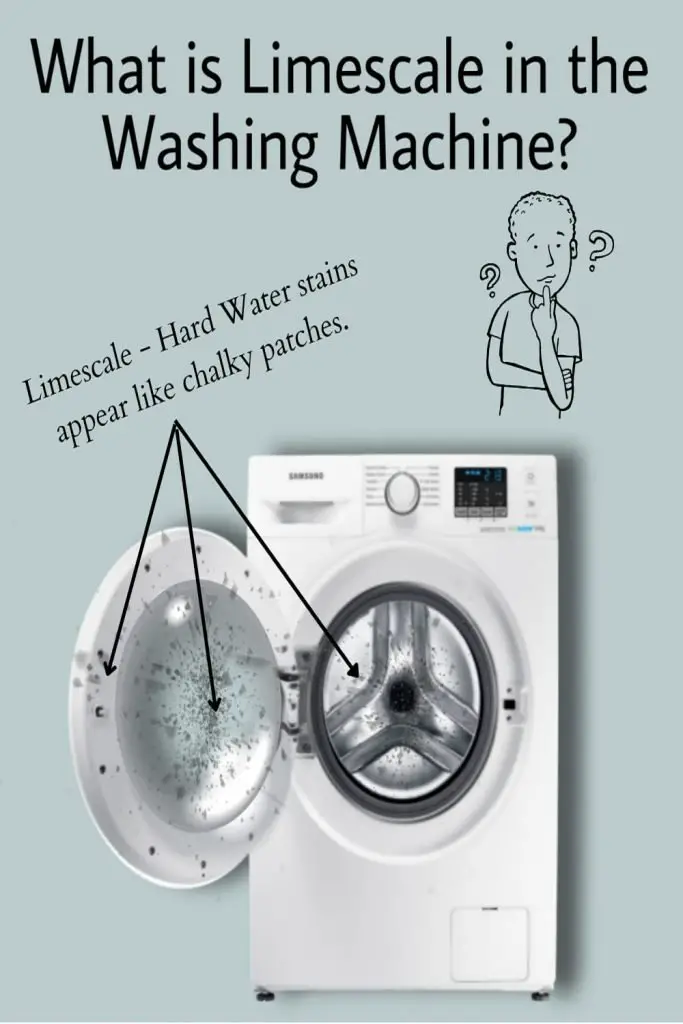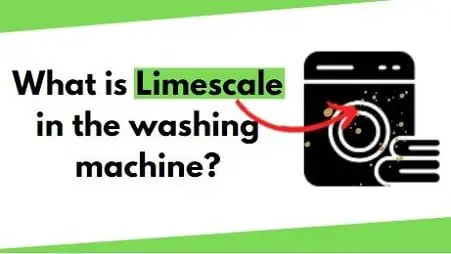A Limescale is a build-up of white, chalky, and scaly patches formed due to repeated exposure to hard water. You can use a descaler or vinegar along with lemon juice to get rid of limescale from your washing machine.
Hard water contains magnesium minerals and calcium contents, these mineral builds up over time and causes Limescale formation.
Limescale deposits can be seen around the household, mostly on the surfaces which have regular contact with hard water such as kitchen taps, sinks, pipes, etc.
Similarly, due to regular hard water contact, these Limescale deposits start to show on your washer.
While regularly using the washer, at times you may notice white spots like stains in the wash drum area.
This indicates that you are in a region that has a hard water supply.
Table of Contents
How does a limescale form in a washer?
When your washer comes in constant contact with hard water there are higher possibilities of Limescale deposits.
It appears in the form of white patches that can be seen inside the washtub area.
Not only the wash drum, but the hard water also gets in contact with several other connected parts of the washer such as the hose, pipe, seals, etc. thereby resulting in Limescale formation.
In such situations, you may use a water softener or vinegar while washing your clothes.
Having said that, most detergents these days are formulated with water softening components that can be used in your laundry.
You can also use several home treatments to soften the water such as using baking soda or maybe vinegar.
How to get rid of limescale in the washing machine?
There are two ways to get rid of Limescale from your washer.
- Using Washing Machine Cleaner
- Using home remedy
Get rid of Limescale using Washing Machine Cleaner
The best practice would be to prevent limescale formation in the washing machine in the first place.
If your washer already has limescale buildups then you can get rid of it with a few steps.
You may use a suitable washing machine cleaner like Affresh that is formulated with solutions that remove limescale from the washer.
All you need to do is simply add the cleaning solution to the washtub and run a normal or clean cycle using hot water.
There are several home remedies to get rid of limescale buildups from the washers amongst which baking soda is the most common compound.
Getting rid of Limescale using a home remedy
Using baking soda is one of the most common home remedies for eliminating limescale.
- For better results make a thick paste of baking soda.
- Use 1 cup of baking soda and mix with sufficient water in a bowl to form a thick paste.
- Apply the paste with a soft brush to the affected areas in the wash drum and leave the application to settle for 30 minutes on the surface.
- Run a cleaning or normal cycle with the hottest water temperature.
- Additionally, after the wash cycle is completed, you can wipe off the reachable areas of the washer with a soft cloth dipped in distilled vinegar.
Another technique is to add a cup of baking soda directly to the washtub and run the clean or normal cycle with hot water.
How to make limescale remover at home?
There are several home treatments that can be applied to get rid of limescale.
There are three methods to make an effective limescale remover.
- By Using Vinegar Solution
- By Using Lemon
- By Using a Hybrid method
Make Limescale remover using Vinegar
In order to prepare a limescale remover using vinegar, you will simply need the below items.
What you will need
- Vinegar
- Spray Bottle
- Water
Prepare the solution
- Add vinegar ⅓ part Vinegar and the remaining part water to the spray bottle.
- Spray the mixture on the affected surface and leave it to settle for some time and wipe it with a cloth or simply run the wash cycle.
Make Limescale remover using Lemon Juice
Lemon juice is most effective in removing the limescale.
You may use a similar technique as discussed above.
What you will need
- Half Part Lemon Juice
- Half Part Water
Prepare the solution
Mixing half part water and half part lemon juice in a spray bottle can make an excellent limescale removal solution.
Thoroughly spray the mixture on the affected areas and leave it to settle for 30 minutes. Wipe with a soft cloth or just run a normal cycle with hot water.
Make Limescale remover using Hybrid Method
A mixture of lemon juice and distilled vinegar together in a wash or clean cycle gives you the best results.
For instance, you may add 2 spoons of vinegar and 2 spoons of lemon juice and run a normal or clean cycle with hot water will give you excellent results, also your washer will smell fresh due to the lemon mixture.
Can vinegar get rid of limescale?
Yes, Vinegar (diluted acetic acid) is said to be the most effective treatment to get rid of limescale. It helps in breaking down the Limescale residues from the surfaces.
Can lemon juice get rid of limescale?
Yes, the citric acid component of lemon juice is one of the most effective solutions to remove limescale deposits. Similar to vinegar, lemon’s natural acidic component breaks down the formation of calcium carbonate properties that causes limescale.
Does Calgon get rid of limescale?
Calgon is amongst the best washing machine cleaners which come in the form of powder, tablets, and liquid gel. The water softening formula of the Calgon solution helps in preventing the build-up of limescale. Apart from eliminating the bacteria (mold and mildew) and residue buildup it also helps in removing the existing limescale build-ups from your washer. It is said to work in three-step action
- Neutralizes the new limescale formation
- Discourages the buildup process
- Clears the existing limescale through the wash
What are the signs of limescale buildup in a washing machine?
White Residue on Clothes
One of the most noticeable signs of limescale buildup is the appearance of white, chalky deposits on your clothes.
This is especially evident in dark fabrics, the limescale acts as a residue that sticks to the material, making your clothes look less clean than they should be.
Reduced Cleaning Performance
Another sign to look out for is reduced cleaning performance.
Limescale can interfere with the effectiveness of your detergent, resulting in clothes that aren’t as clean as they should be.
This is a clear indication that scale buildup is affecting your washing machine’s ability to clean properly.
Clogged Detergent Dispenser
If you notice that your detergent dispenser is not functioning as it should, limescale could be the culprit.
The buildup can clog the dispenser, making it difficult for the detergent to flow into the wash cycle, thereby affecting the overall cleaning process.
Longer Washing Times
Limescale buildup can also lead to longer washing times.
Due to reduced water flow caused by mineral buildup, your washing machine may take longer to complete a cycle, which is both inconvenient and energy-inefficient.
Noisy Operation
If your washing machine starts making more noise than usual during the wash cycle, this could be another sign of limescale formation.
The buildup of limescale on heating elements and other components can cause increased noise, signaling that it’s time for some washing machine maintenance.
Effects of limescale on a washing machine
Increased Energy Consumption
Another significant impact of limescale formation is increased energy consumption.
When the heating elements are coated with limescale, they require more energy to heat the water, leading to higher electricity bills.
Damage to the Washing Machine Parts
Limescale can also cause physical damage to the internal parts of your washing machine, including clogged pipes and a malfunctioning heating element.
This can lead to costly repairs and even necessitate the replacement of certain components.
Reduced Lifespan of the Washing Machine
The cumulative effects of limescale can lead to a shorter lifespan for your washing machine.
The constant strain on its components due to scale buildup can cause them to wear out more quickly, reducing the machine’s overall longevity.
Washing Machine Breakdown
In extreme cases, limescale buildup can lead to a complete breakdown of your washing machine.
Components like the heating element may fail entirely, rendering the machine unusable until repaired or replaced.
How to Prevent Limescale Buildup in a Washing Machine?
Use a Water Softener
One of the most effective ways to prevent limescale buildup is by using a water softener.
But first, it’s important to understand the difference between hard water and soft water.
Hard water contains a high concentration of minerals like calcium and magnesium, which are the primary culprits behind limescale formation.
Soft water, on the other hand, has fewer of these minerals.
By using a water softener, you can convert hard water into soft water, thereby reducing the risk of limescale buildup in your washing machine.
Add a Descaling Agent to Your Washing Machine Detergent
Another effective method to prevent limescale is by adding a descaling agent to your regular detergent.
These agents are specifically designed to break down the mineral deposits that form limescale, keeping your machine’s components clean and efficient.
Run a Regular Cleaning Cycle with Vinegar or Lemon Juice
Natural cleaning solutions like vinegar and lemon juice are also excellent for limescale removal.
Running a regular cleaning cycle with either of these can help dissolve mineral buildup and keep your washing machine in optimal condition.
Simply add a cup of vinegar or lemon juice to an empty wash cycle and run it on the hottest setting to effectively combat limescale.
Tips To Choose the Right Descaling Product for Your Washing Machine
Consider the Water Hardness Level
Before choosing a descaling agent, it’s crucial to know the water hardness level in your area.
Some products are formulated to handle extremely hard water, while others are suitable for moderately hard water.
Knowing your water hardness level will help you select the most effective product.
Check Compatibility with Your Washing Machine
Not all descaling agents are compatible with every washing machine model.
Always read the manufacturer’s guidelines or consult the user manual to ensure that the product you choose won’t harm your machine.
Look for Eco-Friendly Options
If you’re environmentally conscious, consider opting for eco-friendly descaling agents.
These products are usually biodegradable and free from harmful chemicals, making them a sustainable choice for limescale removal.
Read Customer Reviews
Customer reviews can provide valuable insights into the effectiveness of a descaling product.
Look for reviews that specifically mention limescale removal and washing machine maintenance to gauge whether the product is right for you.
Test a Small Amount First
Before using a new descaling agent, it’s advisable to test a small amount first.
This will allow you to see how well it works and ensure it doesn’t cause any adverse effects on your washing machine.
Final Thoughts
Hard water is the primary cause of the formation of limescale.
Using water softeners is a best practice to prevent the washer from limescale buildups.
For existing limescale buildups you may use a cleaner that is easily available online or at local stores.
Home remedies solutions can be used to get rid of limescale and further buildups.
For more information and care tips for your laundry do visit our FAQ section.

You May Also Like
- Washing Machine Descalers: 13 Answers You Should Know
- How to Descale a Washing Machine? (Step by Step)
- Washing Machine Drawer Not Emptying? Here’s the Fix!
- Clean Your Washing Machine Detergent Drawer in 5 Mins
- Washing Machine Care: 16 Tips to Keep It Running for Years
- How to Winterize a Washing Machine? (6 Easy Steps)

